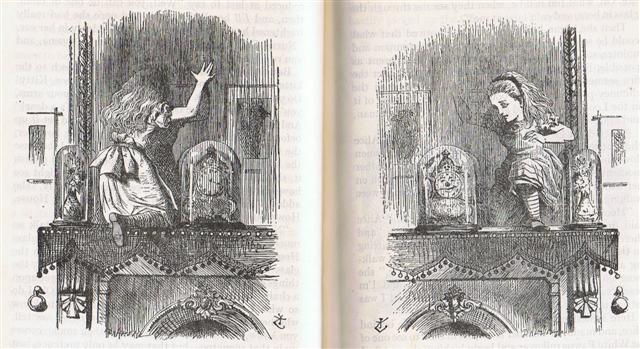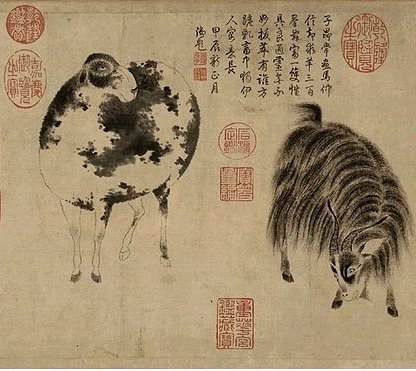435. The number of Pachamama
tresses can be perceived in various ways but clearly
there is a kind of 'mirror' in the center:
|
Counting the tresses from right to left: |
|
1 |
26 |
78 |
1 |
29 |
90 |
|
2 |
26 |
2 |
30 |
|
3 |
26 |
3 |
31 |
|
4 |
25 |
182 - 157 |
4 |
34 |
214 - 180 |
|
5 |
26 |
78 |
5 |
31 |
90 |
|
6 |
27 |
6 |
30 |
|
7 |
26 |
7 |
29 |
|
Total = 396 = 182 + 214 = 2 * 168 + 60 |
|
 |

2 * (78 + 90) = 336 is the day number
for December 2 and with the Julian spring equinox at
day 84 ('March 25) a pair of quarters will be 2 * 84
= 168.
Counting 25 days ahead from Rigel
(*78) we will find signs of the Double Nature:
|
tagata tuu rima ki
ruga |
te maitaki |
te henua |
Rei hata ia |
tagata rogo |
 |
 |
 |
 |
 |
|
Ca3-21 (→ March 21 → Gregorian
equinox) |
Ca3-22 (73 = 365 / 5) |
Ca3-23 |
Ca3-24 (75 = 300 / 4)
|
Ca3-25
(→ March 25→ Julian equinox) |
|
CLOSE TO THE FULL MOON: |
|
June 1 (152)
π4 Orionis (72.1), ο¹ Orionis
(72.4), π5 Orionis (72.8) |
2 (32 + 11 * 11)
π¹ Orionis (73.0), ο² Orionis
(73.4),
HASSALEH = ι Aurigae
(73.6), π6 Orionis (73.9) |
3
ALMAAZ (The Male Goat) = ε Aurigae
(74.7),
HAEDUS I = ζ Aurigae
(74.8) |
4
HAEDUS II = η Aurigae
(75.9) |
5 (115 + 41 = 80 + 76)
5h (76.1)
ε Leporis (76.0),
CURSA = β Eridani
(76.4), λ Eridani (76.7) |
|
21 (111 = 152 - 41) |
"April 22 (*32 = 73 - 41) |
23 |
24 |
Vaitu
Nui 25 (→ Mercury) |
|
... [E:17] On the twenty-fifth
day of the first month (Vaitu
Nui), Ira and Makoi
set sail; on the first day of June
('Maro'), the bow of Ira's
canoe appeared on the distant
horizon, came closer and closer on
its course, and sailed along, and
finally (one) could see the (new
home) land ...
 |
|
By
using the time-frame of Bharani as a
stepping stone it was evidently
possible to go back in time-space to
the age of Virgo by reducing its
right ascension day numbers with 80.
This will bring us to the time when
Spica was around day *81 (= *202 -
*80 -*41), i.e. around day 282 - 121
= 161 (JUNE 10), when the
month of Jus Piter (Jupiter, Father
Light) was beginning.
At
the same time Canopus (175, St
John's Day) should have been around
day 175 - 80 - 41 = 54 (= 31 + 23
i.e. at TERMINALIA), to be
compared with *54 ("May 14) = *95 -
*41. |
|
JAN 31 (= 172 - 141) |
(32 = 73 - 41) |
FEBR 2 |
3 |
4
(115 - 80) |
|
kua tupu te
rakau |
kua tupu - te
kihikihi |
te hau tea |
22 |
 |
 |
 |
|
Ca4-1 |
Ca4-2 (78) |
Ca4-3 |
|
CLOSE TO THE FULL MOON: |
|
... In view of the almost
universal prevalence of the
Pleiades year throughout the
Polynesian area it is surprising
to find that in the South Island
and certain parts of the North
Island of New Zealand and in the
neighboring Chatham Islands, the
year began with the new Moon
after the yearly morning rising,
not of the Pleiades, but of the
star Rigel in Orion
... |
|
June 6 (157 = 314 / 2)
μ Aurigae, μ Leporis (77.6) |
7 (*78)
ĸ Leporis (78.0),
RIGEL (Foot) = β Orionis
(78.1),
Flaming Star = IC405
(78.2),
CAPELLA = α Aurigae
(78.4), ο Columbae, τ Orionis
(78.8)
*37.0 = *78.4 - *41.4
THUBAN (α Draconis)
|
8
λ Aurigae (79.0), λ Leporis
(79.6), ρ Aurigae (79.7)
ARCTURUS (α Bootis)
|
|
'May 10 (*50 = *77 - * 27) |
11 |
12 (132 = 118 + 14) |
|
"April 26 (*36 = *77 - *41) |
27 |
28 (118 = 472 / 4) |
|
APRIL 3 (*13 = *77 - *64) |
4 |
5 (95 = 118 - 23) |
|
FEBR 5 (36) |
6 (37 = 78 - 41) |
7 (118 - 80) |
|
... the Palenque scribes
repeated Creation again and
described it as 'it was made
visible, the image at
Lying-down-Sky, the
First-Three-Stone-Place'. Then
we learned that five hundred and
forty-two days later (1.9.2 in
the Maya system), Hun-Nal-Ye
'entered or became the sky' (och
ta chan). This 'entering'
event occurred on February 5,
3112 BC ... |
|
erua tamaiti |
kua vaha te mago
erua |
 |
 |
 |
 |
|
Ca4-26 |
Ca4-27 (78 + 25) |
Ca4-28 (104) |
Ca4-29 |
|
CLOSE TO THE FULL MOON: |
|
July 1 (182 = 157 + 25)
τ Puppis (102.2), ψ7 Aurigae (102.4) |
2 (*103 = *78 + *25)
Mash-mashu-sha-Risū-9 (Twins of
the Shepherd)
θ Gemini (103.0), ψ8 Aurigae
(103.2),
ALHENA = γ Gemini
(103.8), ψ9 Aurigae (103.9) |
3
ADARA (Virgins) = ε Canis Majoris
(104.8) |
4 (185)
ω Gemini (105.4),
ALZIRR (Button) = ξ Gemini
(105.7),
MULIPHEIN (Oaths) = γ Canis Majoris
(105.8),
MEKBUDA (Contracted) = ζ Gemini
(105.9) |
|
... Al Maisān, the title of
γ
Geminorum [Alhena], by some error of
Firuzabadi was applied to this star
[Heka in Orion] as Meissa,
and is now common for it. Al Sufi
called it Al Tahāyī; but Al
Ferghani and Al Tizini knew it as
Rās al Jauzah, the Head of the
Jauzah, which it marks. The original
Arabic name, Al Hak'ah, a
White Spot, was from the added faint
light of the smaller
φ¹and
φ²
in the background, and has descended
to us as Heka and Hika.
These three stars were another of
the Athāfiyy [tripods used
for cooking] of the Arabs; and
everywhere in early astrology were
thought, like all similar groups, to
be of unfortunate influence in human
affairs. They constituted the
Euphratean lunar station
Mas-tab-ba-tur-tur, the Little
Twins, a title also found for
γ
[Alhena] and
η
Geminorum [Tejat Prior]; and
individually were important stars
among the Babylonians, rising to
them with the sun at the summer
solstice, and, with
α
and
γ,
were known as Kakkab Sar, the
Constellation of the King
|
|
'June 4
(132 + 23) |
5 (156) |
6 (314 / 2) |
7 |
|
"May 21 (118 + 23) |
22 (142 = 156 - 14) |
23 |
24 (12 * 12) |
|
APRIL 28 (95 + 23) |
29 (119 = 156 - 37) |
30 |
MAY 1 (11 * 11) |
|
MARCH 2 (38 + 23) |
3 (62 = 183 - 121) |
4 |
5 (8 * 8) |

If Rigel (*78) was the
beginning, then we perhaps could count
not only (following the tresses) to *78
+ *25 = *103 (Alhena) but also to Ga4-2
(78) to 78 + 34 = 112 (Ga5-7), which
indeed appears to be supported by the
glyphs:
|
4 |
kua iri i te
rakau |
ihe tamaiti |
erua mago |
|
Iri.
1. To go up; to
go in a boat on the sea (the
surface of which gives the
impression of going up from the
coast): he-eke te tagata ki
ruga ki te vaka, he-iri ki te
Hakakaiga, the men boarded
the boat and went up to
Hakakainga. 2. Ka-iri ki
puku toiri ka toiri. Obscure
expression of an ancient curse.
Vanaga. Iri-are, a
seaweed. Vanaga. |
 |
 |
 |
 |
|
Ca5-5 |
Ca5-6 (111) |
Ca5-7 (78 + 34) |
Ca5-8 |
|
CLOSE TO THE FULL MOON: |
|
July 9
no star listed (110) |
10
ALUDRA (Virgin) = η Canis
Majoris (111.1), PROPUS = ι Gemini (111.4),
GOMEISA (Water-eyed) = β Canis
Minoris (111.6) |
11 (*112)
ρ Gemini (?) (112.1),
Eskimo Nebula = NGC2392 Gemini
(112.2)
ANTARES (α Scorpii)
|
12 (193)
Al Dhirā'-5 (Forearm)
/
Punarvasu-7 /
Mash-mashu-Mahrū-10 (Western One
of the Twins)
CASTOR = α Gemini
(113.4) |
|
... In Hindu legend there was a
mother goddess called Aditi,
who had seven offspring. She is
called 'Mother of the Gods'.
Aditi, whose name means
'free, unbounded, infinity' was
assigned in the ancient lists of
constellations as the regent of
the asterism Punarvasu.
Punarvasu is dual in form
and means 'The Doublegood Pair'.
The singular form of this noun
is used to refer to the star
Pollux. It is not difficult to
surmise that the other member of
the Doublegood Pair was Castor.
Then the constellation
Punarvasu is quite
equivalent to our Gemini, the
Twins. In far antiquity (5800
BC) the spring equinoctial point
was predicted by the heliacal
rising of the Twins ... |
|
'June 12 |
13 (164 = 191 - 27) |
14 (*85) |
15 |
|
"May 29 |
30 (150 = 191 - 41) |
31 (*71) |
"June 1 |
|
MAY 6 |
7 (127 = 191 - 64) |
8 (*48) |
9 |
|
MARCH 10 |
11
(70 = 191 - 121) |
12 (*357 = 366 + 71 - 80) |
13 |

|










